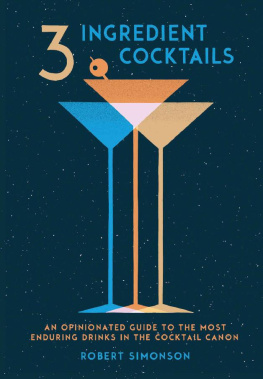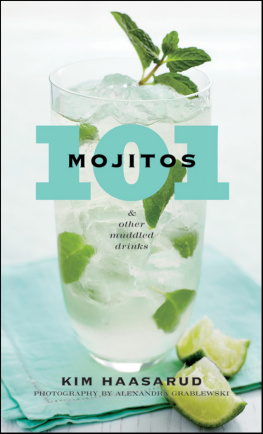
CONTENTS
No1
Introduction
heres how it all started
I began my career as a bartender when I was nineteen, and I quickly realized I was on the right track. It was clear that I was meant to stand behind a bar, and that being a bartender would be perfect for me.
I began studying drinks and analyzing bartenders techniques, without the slightest idea that this was the beginning of an obsession that has yet to end. Even today, I cant sit at a bar without analyzing each and every movement, each and every drink, glass, tool, type of ice, list of drinks, structure, etc., etc. I love it. But at the same time, its something of a cursein a space where others can relax, my mind is still at work.
When I began my career behind the bar, there werent many cocktail bars in Sweden, and the bar scene itself had reached an all-time low a few years before with the introduction of the Galliano Hot ShotSwedens most advanced and cherished alcoholic drink.

Its been said that Galliano opened a new factory in order to meet the demands of the Swedish market for the vanilla-flavored liqueur that was destined to be mixed with coffee and cream. Ive heard horror stories from bartenders who would prepare in advance several hundred of the coffee- and Galliano-layered shots, so they could simply top them with cream as the orders came in. Its also been said that Galliano had to close the new factory just a few years later, when the Hot Shot craze died out as quickly as it had taken over. Fact or fiction, it makes for a good story.
At the time that I got started in the industry, the offerings of most bars were a catastrophe: you blended a powdered sour-mix (every bartender from those years will remember Francos Lime and Orange mixers), juices came in jars, and cranberry juice was the hot new thing. Nobody took the profession seriously, with the exception of a select few significantly older bartenders who were already part of the old gang fifteen years earlier.
But things were about to change. Enthusiasts in London and New York began to add new zeal to the profession, using freshly squeezed juices and adding fresh fruit and pures to their cocktails. Wed constantly be traveling there and back for inspiration (this was before the Internet existed, so you had to actually talk to people in person and hunt them down in crowded placesah, the good old days). There were even some whod pack up their speed pourers and shakers and head for those places where everything was happening, so they could acquire invaluable knowledge about service, technique, and drinks.
Some of us stayed behind and did what we could to convince restaurateurs that they shouldnt see the bar as an unnecessary evil, or see bartenders as a bunch of drunks who just wanted to meet women and get wasted. And slowly but surely, things started to change back in Sweden, too. With age and experience, one had more of a say in things, and to be honest, it wasnt that difficult to stand out at the beginning when the majority of bartenders werent willing to put in the effort thats required to run a bar with higher standards.
I was one of those who had the confidence to work in the ambitious way that I wanted. It wasnt easy, but the reward was so powerful: satisfied guests, professional pride, newspaper reviews, satisfied restaurateurs, more responsibility, better pay, bigger tips, and recognition from colleagues. The more you gave, the more you got back; I became completely obsessed with my work and wanted only to know more, to develop as much as I could. With these changes, completely new kinds of guests came to the bar and were interested in what was going on; the discussions and the general mood in the bar were also different. When you really care, the customers know it, and for us that opened up a whole new world. Everything was better.
Now the industry has come quite far, and with the Internet, the world has simultaneously shrunk and expanded in a way that we would never have thought possible. Any day you want, you can go online and travel the world in search of inspiration. Weve also come a certain distance when it comes to taste. At the beginning, it was all about light spirits, and everything had to be masked with fruit; now were serving stiff cocktails with strong spirits, like the Star Cocktail. People have really begun to appreciate the taste of alcohol, which makes my job so much more fun.
Ive had the good fortune to be able to open more bars in Stockholm than any other bartender, and Ive been involved in the development of Swedens modern cocktail scene. Its been hard work, but at the same time, unbelievably fun. This book is something of a recap of that time, but above all, its really a damn awesome book of drinks.
ONCE UPON A TIME
I thought Id try to explain a bit about the era that inspired modern cocktail culture, since so much of the industry builds on what others have done in the past.
The cocktail and the bartending profession hail from America; its heyday ran from about 1850 to 1935. The bar was where people met before work, during work, and after work (assuming they still had work). The bar was the obvious middle ground, and the bartender was the star. Bartenders often belonged to the Sporting Fraternitythat is, people who lived to bet on horses and boxing matches. They were usually also well-traveled, and offered immeasurable wisdom from behind the counter. Of course, people drank themselves stupid far too often, and the harmful effects of alcohol had yet to be discoveredapart from those effects that the wives and children had to put up with when the men were drunk, so its not difficult to understand why Prohibition was introduced.
It was during this time that bartenders like Jerry Thomas, O. H. Byron, Harry Johnson, Thomas Stuart, and Harry Craddock, to name a few, wrote their bartending manuals, which now serve as bibles for the modern bartender. Initially, these were written simply for the authors fellow tradesmen, and were not intended to be read by other folk. Since you couldnt just walk to the nearest supermarket (or liquor store, for that matter), these men prepared everything from scratch: bitters, flavored syrups, soda, spirits, and everything else they needed. They were chemists, mixologists, psychologists, entertainers, ruffians, gamblers, and yes, heroes. These books have since been rediscovered by enthusiasts and reproduced, so that the new generation has been able to learn the principles of the trade.
A few years later, a new era of cocktails swept across the world, and bartenders have once again become a class of professionals, practicing their craft with pride. The tradition is protected, the trade taken seriously; once again, we can enjoy cocktails like Corpse Revivers, Brandy Crustas, and perfect Old Fashioneds, while also creating new drinks with the help of new techniques, new ingredients, and modern ideas. Its a wonderful time to sit in bars, try new creations, and discover new tastes.
Cocktails have never tastedor beenbetter than they are now!

















